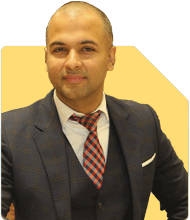Ramalingam Kalirajan |7271 Answers |Ask -Follow
Mutual Funds, Financial Planning Expert - Answered on May 29, 2024
He has an MBA in finance from the University of Madras and is a certified financial planner.
He is the director and chief financial planner at Holistic Investment, a Chennai-based firm that offers financial planning and wealth management advice.... more

I have only invested in Industrial and Residential real estate and built a strong portfolio. Now I want to spread my risk and I have 1 Cr which I plan to invest in MF’s , FD’s, Liquid schemes and Shares. My target is CAGR of 12-15 % over a short term period 3-5 years with liquidity. I have not invested in shares/ MF till now but am studying pattern of blue chip shares live HDFC , Reliance etc for past 6 months to understand a pattern. How do I start ? Create my own portfolio of blue chip shares or go for mutual fund or mix of both? Could you suggest an allocation of 1 CR to achieve desired CAGR?
Understanding Your Goals
Your goals are clear: achieve a 12-15% CAGR over 3-5 years. You also seek liquidity, which is important for financial flexibility. Diversifying beyond real estate is a smart move.
Risk and Return
Different investments have different risk levels. Mutual funds and shares can offer high returns but come with higher risk. Fixed deposits and liquid schemes are safer but offer lower returns. Balancing these can help you achieve your desired CAGR.
Mutual Funds
Mutual funds are a great way to invest in a diversified portfolio. They are managed by professionals who aim to outperform the market. Actively managed funds can potentially provide better returns than index funds, especially in volatile markets.
Shares
Investing in blue-chip shares like HDFC and Reliance can be rewarding. These companies have strong track records and stable performance. However, individual stock picking requires time and expertise. You must monitor the market closely and stay informed about each company's performance.
Fixed Deposits
Fixed deposits offer safety and assured returns. They are ideal for preserving capital and earning steady income. However, their returns are lower compared to equities and mutual funds. They are suitable for the conservative part of your portfolio.
Liquid Schemes
Liquid schemes provide high liquidity with lower risk. They are ideal for parking funds temporarily or for emergency needs. While they offer lower returns compared to equities, they provide stability and easy access to funds.
Creating a Balanced Portfolio
A balanced portfolio can help you achieve your CAGR target while managing risk. Here’s a suggested allocation:
Mutual Funds: Allocate 50% (Rs 50 lakhs) to a mix of equity mutual funds. Choose funds with a track record of high performance and good management. Actively managed funds can help achieve higher returns.
Shares: Allocate 20% (Rs 20 lakhs) to blue-chip shares. Invest in companies with strong fundamentals and growth potential. This portion requires regular monitoring and knowledge of market trends.
Fixed Deposits: Allocate 20% (Rs 20 lakhs) to fixed deposits. This will ensure safety and provide a steady return. It’s a good way to balance the riskier part of your portfolio.
Liquid Schemes: Allocate 10% (Rs 10 lakhs) to liquid schemes. This ensures high liquidity and funds availability for emergencies or short-term needs.
Actively Managed Funds vs. Index Funds
Actively managed funds aim to outperform the market through expert management. They can provide higher returns compared to index funds, especially in volatile markets. Index funds simply track market indices and may underperform in uncertain conditions.
Regular Funds vs. Direct Funds
Investing through a certified financial planner in regular funds has benefits. They provide expert advice, tailored recommendations, and ongoing portfolio management. Direct funds lack professional guidance and can be more challenging for inexperienced investors.
Importance of Professional Guidance
Working with a Certified Financial Planner can help you make informed decisions. They can offer tailored advice, adjust your portfolio based on market conditions, and help you achieve your financial goals.
Monitoring and Rebalancing
Regularly review and rebalance your portfolio. Monitor performance, market trends, and adjust allocations as needed. This ensures your investments stay aligned with your goals.
Conclusion
Your plan to diversify beyond real estate is wise. By balancing mutual funds, shares, fixed deposits, and liquid schemes, you can achieve your desired CAGR with manageable risk. Consulting a Certified Financial Planner can further enhance your investment strategy.
Best Regards,
K. Ramalingam, MBA, CFP,
Chief Financial Planner,
www.holisticinvestment.in
You may like to see similar questions and answers below
Omkeshwar Singh | Answer |Ask -Follow
Head, Rank MF - Answered on Oct 13, 2022
Nikunj Saraf | Answer |Ask -Follow
Mutual Funds Expert - Answered on Oct 28, 2022
Nikunj Saraf | Answer |Ask -Follow
Mutual Funds Expert - Answered on Nov 30, 2022
Ramalingam Kalirajan |7271 Answers |Ask -Follow
Mutual Funds, Financial Planning Expert - Answered on May 29, 2024
Mihir Tanna |975 Answers |Ask -Follow
Tax Expert - Answered on Dec 17, 2024
Mihir Tanna |975 Answers |Ask -Follow
Tax Expert - Answered on Dec 17, 2024
Mihir Tanna |975 Answers |Ask -Follow
Tax Expert - Answered on Dec 17, 2024
Mihir Tanna |975 Answers |Ask -Follow
Tax Expert - Answered on Dec 17, 2024
Dr Anshuman Manaswi |14 Answers |Ask -Follow
Plastic-Aesthetic Surgeon, Emergency Care Consultant - Answered on Dec 17, 2024
Samraat Jadhav |2121 Answers |Ask -Follow
Stock Market Expert - Answered on Dec 17, 2024
Harsh Bharwani |63 Answers |Ask -Follow
Entrepreneurship Expert - Answered on Dec 17, 2024
Anu Krishna |1402 Answers |Ask -Follow
Relationships Expert, Mind Coach - Answered on Dec 17, 2024
Anu Krishna |1402 Answers |Ask -Follow
Relationships Expert, Mind Coach - Answered on Dec 17, 2024
Anu Krishna |1402 Answers |Ask -Follow
Relationships Expert, Mind Coach - Answered on Dec 17, 2024




























